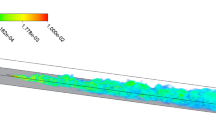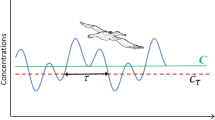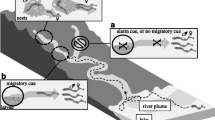Abstract
Characterization of vertebrate chemo-orientation strategies over long distances is difficult because it is often not feasible to conduct highly controlled hypothesis-based experiments in natural environments. To overcome the challenge, we couple in-stream behavioral observations of female sea lampreys (Petromyzon marinus) orienting to plumes of a synthesized mating pheromone, 7α,12α,24-trihydroxy-5α-cholan-3-one-24-sulfate (3kPZS), and engineering algorithms to systematically test chemo-orientation hypotheses. In-stream field observations and simulated movements of female sea lampreys according to control algorithms support that odor-conditioned rheotaxis is a component of the mechanism used to track plumes of 3kPZS over hundreds of meters in flowing water. Simulated movements of female sea lampreys do not support that rheotaxis or klinotaxis alone is sufficient to enable the movement patterns displayed by females in locating 3kPZS sources in the experimental stream. Odor-conditioned rheotaxis may not only be effective at small spatial scales as previous described in crustaceans, but may also be effectively used by fishes over hundreds of meters. These results may prove useful for developing management strategies for the control of invasive species that exploit the odor-conditioned tracking behavior and for developing biologically inspired navigation strategies for robotic fish.



Similar content being viewed by others
References
Abarbanel HD, Brown IR, Sidorowich JJ, Tsimring LS (1993) The analysis of observed chaotic data in physical systems. Rev Mod Phys 65:1331–1392
Applegate VC (1950) The natural history of the sea lamprey (Petromyzon marinus) in Michigan. U.S. Department of Interior, Fish & Wildlife Service, Washington, D.C. Special Scientific Report: Fisheries No. 55
Baker CF, Montgomery JC, Dennis TE (2002) The sensory basis of olfactory search behavior in banded kokopu (Galaxias fasciatus). J Comp Physiol A 188:553–560
Balkvosky E, Shraiman BI (2002) Olfactory search at high Reynolds number. P Natl Acad Sci USA 20:12589–12593
Binder TR, McDonald DG (2007) Is there a role for vision in the behavior of sea lampreys (Petromyzon marinus) during their upstream spawning migration? Can J Fish Aquat Sci 64:1403–1412
Carton AG, Montgomery JC (2003) Evidence of a rheotactic component in the odor search behavior of freshwater eels. J Fish Biol 62:501–516
Chang H-G, Freeman WJ, Burke BC (1998) Biologically modelled noise stabilizing neurodynamics for pattern recognition. Int J Bifurcat Chaos 8:321–345
Doving KB, Stabell OB (2003) Trails in open waters: sensory cues in salmon migration. In: Collin SP, Marshall NJ (eds) Sensory processing in aquatic environments. Springer-Verlag, New York, pp 39–59
Dusenbery DB (1992) Sensory ecology: How organisms acquire and respond to information. W. H. Freeman, New York
Fraenkel GS, Gunn DL (1961) Orientation of animals. Dover Publication, Mineola
Gardiner JM, Atema J (2007) Sharks need the lateral line to locate odor sources: rheotaxis and eddy chemotaxis. J Exp Biol 210:1925–934
Grasso FW, Atema J (2002) Integration of flow and chemical sensing for guidance of autonomous marine robots in turbulent flows. Environ Fluid Mech 2:95–114
Grasso F, Dale JH, Consi TR, Mountain DC, Atema J (1997) Effectiveness of continuous bilateral sampling for robot chemotaxis in a turbulent odor plume: implications for lobster chemo-orientation. Biol Bull 193:215–216
Grasso FW, Consi TR, Mountain DC, Atema J (2000) Biomimetic robot lobster performs chemo-orientation in turbulence using a pair of spatially separated sensors: progress and challenges. Robot Auto Syst 30:115–131
Grunbaum D (1998) Schooling as a strategy for taxis in a noisy environment. Evol Ecol 12:503–522
Hodgson ES, Mathewson RF (1971) Chemosensory orientation of sharks. Ann NY Acad Sci 188:174–182
Jatmiko W, Mursanto P, Kusumoputro B, Sekiyama K, Fukuda T (2008) Modified PSO algorithm based on flow and wind for odor source localization problems in dynamic environments. WSEAS Trans Sys 7:106–113
Johnson NS, Li W (2010) Understanding behavioral responses of fish to pheromones in natural freshwater environments. J Comp Physiol A 196:701–711
Johnson NS, Siefkes MJ, Li W (2005) Capture of ovulating female sea lampreys in traps baited with spermiating male sea lampreys. N Am J Fish Manage 25:67–72
Johnson NS, Luehring MA, Siefkes MJ, Li W (2006) Pheromone induced behavior and pheromone reception in ovulating female sea lampreys. N Am J Fish Manage 26:88–96
Johnson NS, Yun S-S, Thompson HT, Brant CO, Li W (2009) A synthesized pheromone induces upstream movement in female sea lamprey and summons them into traps. P Natl Acad Sci USA 106:1021–1026
Jones FRH (1968) Fish migration. Edward Arnold, London
Kanter MJ, Coombs S (2003) Rheotaxis and prey detection in uniform currents by Lake Michigan mottled sculpin (Cottus bairdi). J Exp Biol 206:59–70
Kennedy JS, Marsh D (1974) Pheromone-regulated anemotaxis by flying moths. Science 184:999–1001
Kleerekoper H (1972) The sense organs. In: Hardisty MW, Potter IC (eds) The biology of lampreys, 2nd edn. Academic Press, London, pp 373–404
Kleerekoper H, Sibakin K (1956) Spike potentials produced by the sea lamprey (Petromyzon marinus) in the water surrounding the head region. Nature 178:490–491
Li W, Sorensen PW, Gallaher DD (1995) The olfactory system of migratory adult sea lamprey (Petromyzon marinus) is specifically and acutely sensitive to unique bile acids released by conspecific larvae. J Gen Physiol 105:569–587
Li W, Farrell JA, Carde RT (2001) Tracking of fluid-advected odor plumes: strategies inspired by insect orientation to pheromone. Adapt Behav 9:143–170
Li W, Scott AP, Siefkes MJ, Yan H, Liu Q, Yun S-S, Gage DA (2002) Bile acid secreted by male sea lamprey that acts as a sex pheromone. Science 296:138–141
Manion PA, Hanson LH (1980) Spawning behavior and fecundity of lampreys from the upper three Great Lakes. Can J Fish Aquat Sci 37:1635–1640
Montgomery JC, Baker CF, Carton AG (1997) The lateral line can mediate rheotaxis in fish. Nature 389:960–963
Moore PA, Scholz N, Atema J (1991) Chemical orientation of lobsters, Homarus americanus, in turbulent odor plumes. J Chem Ecol 17:1293–1307
Moore PA, Grills JL, Schneider WS (2000) Habitat-specific signal structure for olfaction: an example from artificial streams. J Chem Ecol 26:565–584
Murlis J, Willis MA, Carde RT (2000) Spatial and temporal structures of pheromone plumes in fields and forests. Physiol Entomol 25:211–222
Myers JL, Well AD (2002) Research design and statistical analysis. Florence, KY
Nevitt GA, Losekoot M, Weimerskirch H (2008) Evidence for olfactory search in wandering albatross, Diomedea exulans. Proc Natl Acad Sci USA 105:4576–4581
Oliver SJ, Grasso FW, Atema J (1996) Filament tracking and casting in American elvers (Anguilla rostrata). Biol Bull 191:315–315
Page JL, Dickman BD, Webster DR, Weissburg MJ (2011) Staying the course: chemical signal spatial properties and concentration mediate cross-stream motion in turbulent plumes. J Exp Biol 214:1513–1522
Pang S, Farrell JA (2006) Chemical plume source localization. IEEE T Syst Man Cy B 36:1068–1080
Pasternak Z, Blasius B, Achituv Y, Abelson A (2004) Host location in flow by larvae of the symbiotic barnacle Trevathana dentate using odor-gated rheotaxis. Proc R Soc London 271:1745–1750
R Development Core Team (2009) R: a language and environment for statistical computing. R Foundation for Statistical Computing, Vienna, Austria. ISBN: 3-900051-07-0. http://www.R-project.org. Accessed 25August2009.
Rittschof D, Williams LG, Brown B, Carriker MR (1983) Chemical attraction of newly hatched oyster drills. Biol Bull 164:493–505
Scholz AT, Horrall RM, Cooper JS, Hasler AD (1975) Imprinting to chemical cues: the basis for home stream selection in salmon. Science 192:1247–1249
Sherman ML, Moore PA (2001) Chemical orientation of brown bullheads, Ameiurus nebulosus, under different flow conditions. J Chem Ecol 27:2301–2318
Siefkes MJ, Winterstein JS, Li W (2005) 3-Keto petromyzonol sulfate specifically attracts ovulating female sea lamprey (Petromyzon marinus). Anim Behav 70:1037–1045
Sorensen PW, Fine JM, Dvorknikovs V, Jeffrey CS, Shao F, Wang J, Vrieze LA, Anderson KR, Hoye TR (2005) Mixture of new sulfated steroids functions as a migratory pheromone in the sea lamprey. Nat Chem Biol 1:324–328
Vickers NJ (2000) Mechanisms of animal navigation in odor plumes. Biol Bull 198:203–212
Vrieze LA, Bergstedt RA, Sorensen PW (2011) Olfactory-mediated stream-finding behavior of migratory adult sea lamprey (Petromyzon marinus). Can J Fish Aquat Sci 68:523–533
Webster DR, Weissburg MJ (2001) Chemosensory guidance cues in a turbulent chemical odor plume. Limnol Oceanogr 46:1034–1047
Webster DR, Weissburg MJ (2009) The hydrodynamics of chemical cues among aquatic organisms. Annu Rev Fluid Mech 41:73–90
Webster DR, Volyanskyy KY, Weissburg MJ (2012) Bioinspried algorithm for autonomous sensor-driven guidance in turbulent chemical plumes. Bioinspir Biomim 7:036023
Weissburg MJ (2000) The fluid dynamic context of chemosensory behavior. Biol Bull 198:188–202
Weissburg MJ, Dusenbery DB (2002) Behavioral observations and computer simulations of blue crab movement to a chemical source in a controlled turbulent flow. J Exp Biol 205:3387–3398
Weissburg MJ, Zimmer-Faust RK (1994) Odor plumes and how blue crabs use them in finding prey. J Exp Biol 197:349–375
Westerberg H (1982) Ultrasonic tracking of Atlantic salmon (Salmo salar L.) 2. Swimming depth and temperature stratification. Institute of Freshwater Research Drottningholm Report 60:102–120
Xi X, Johnson NS, Brant CO, Yun S-S, Chambers KL, Jones AD, Li W (2011) Quantification of a male sea lamprey pheromone in tributaries of Laurentian Great Lakes by liquid chromatography–tandem mass spectrometry. Environ Sci Technol 45:6437–6443
Yu J, Tan M, Wang S, Chen E (2004) Development of a biomimetic robotic fish and its control algorithm. IEEE T Syst Man Cy B 34:1798–1801
Zimmer-Faust RK, Finelli CM, Pentcheff ND, Wethey DS (1995) Odor plumes and animal navigation in turbulent water flow: a field study. Biol Bull 188:111–116
Acknowledgments
We thank the staffs of U.S. Geological Survey Hammond Bay Biological Station, U.S. Fish and Wildlife Service, Marquette Biological Station and Department of Fisheries and Ocean, Sea Lamprey Control Centre for facilities, sea lamprey, and equipment. Terrance Hubert, Jane Rivera, and David Kennedy of U.S. Geological Survey Upper Midwest Sciences Center helped obtain pheromone use permits from U.S. Environmental Protection Agency. Dolly Trump and Lydia Lorenz provided access to their private lands to conduct field experiments. Thanks to Joseph Bednark, Cory Brant, Nicole Griewahn, Abby Johnson, Margo Nowak, David Partyka, Aaron Smuda, and Erin Walaszczyk for field assistance. Use of trademark names does not represent endorsement by the U.S. Government. This article is Contribution 1710 of the USGS Great Lakes Science Center. In-stream field experiments were supported by the Great Lakes Fishery Commission. A. Muhammad and J. Choi were supported by the National Science Foundation through CAREER Award CMMI-0846547. W. Li was supported in part by the National Science Foundation Awards IOB0517491 and IOB0450916.
Ethical standards
Use of sea lamprey was approved under Michigan State University Institutional Animal Use and Care Committee permit 05/06-066-00. Experiments described in this manuscript comply with the current laws of the United States of America.
Conflict of interest
The authors declare that they have no conflict of interest.
Author information
Authors and Affiliations
Corresponding authors
Additional information
Communicated by P. Buston
Electronic supplementary material
Below is the link to the electronic supplementary material.
ESM 1
(DOCX 5206 kb)
Rights and permissions
About this article
Cite this article
Johnson, N.S., Muhammad, A., Thompson, H. et al. Sea lamprey orient toward a source of a synthesized pheromone using odor-conditioned rheotaxis. Behav Ecol Sociobiol 66, 1557–1567 (2012). https://doi.org/10.1007/s00265-012-1409-1
Received:
Revised:
Accepted:
Published:
Issue Date:
DOI: https://doi.org/10.1007/s00265-012-1409-1




